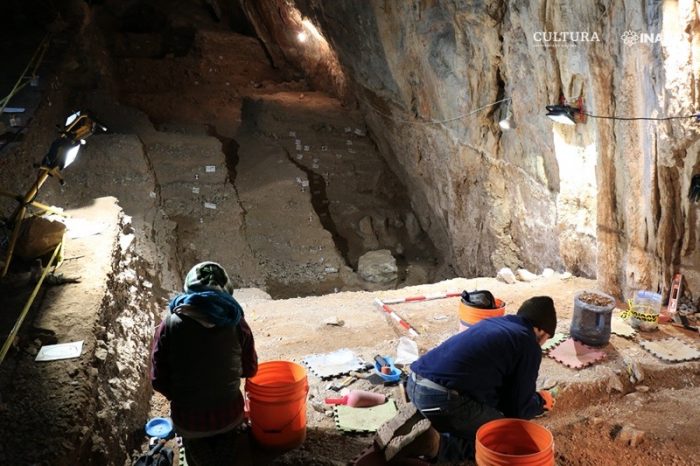The finding was announced on Wednesday in the scientific journal Nature, the result of multidisciplinary research led by Dr. Ciprian Ardelean, from the Autonomous University of Zacatecas. Three INAH researchers are carrying out paleontological studies.
ZACATECAS Mexico (INAH) – A cave with lithic tools of unknown technological tradition was found in the Concepción del Oro municipality. The area has been studied along with animal bone fragments, plant remains, and environmental DNA contained in sediment collected at the site; the results of the laboratory analyses suggest that it was occupied by people between approximately 30,000 and 13,000 years ago. They call it “Cueva del Chiquihuite.”

Photo: Ciprian Ardelean.
The discoveries provide strong evidence that the population of North America was older than assumed two decades ago. That according to other relevant findings in the Chiapas Highlands, central Mexico and flooded caves on the Caribbean coast, corresponding to the end of the Pleistocene and Early Holocene era.
In addition to providing reliable evidence of the ancient human presence in the northwestern region of Mexico, the material evidence indicates the cultural diversity of the first groups dispersed throughout the continent.
This is revealed by multidisciplinary and inter-institutional research published in the scientific journal Nature. Scientists, led by Dr. Ciprian Ardelean, an archaeologist from the Autonomous University of Zacatecas, suggest that North America was sparsely populated, possibly before the Last Glacial Maximum (LGM), which occurred between 18,000 and 27,000 years ago. There were human groups before the Clovis, long considered the first inhabitants of America, 13,500 years old.
In the article, the scientists describe the methods of study in laboratories in Denmark, Oxford (UK) and Mexico (UNAM, SLAA-INAH, ENAH), applied to microscopic samples of bone, carbon, and sediments in which pollen and phytoliths, as well as chemical elements typical of human action, were preserved. This led to the collection of accurate chronological data from more than 50 dates. 46 by radiocarbon, 6 by Optically Stimulated Luminescence (OSL) genetic, palaeoenvironmental, and chemical data documenting changing environments where men and women lived from 30,000 to 13,000 years ago.
They also describe advances in the study of the lithic material recovered from the cave, which totals around 1,900 stone artifacts. They explain that this is an unknown cultural tradition of stonework, which lasted for almost 18,000 years of the site’s occupation.
Ardelean arrived at this site after a year of systematically walking through kilometers of the mountain range in the region of Concepción del Oro in search of ancient human evidence, guided by the interpretation of the shape of the terrain and with the guidance of locals. In 2010, he reached the Chiquihuite Cave, located at 2,740 meters above sea level and approximately 1,000 meters above the valley floor.
The first remains were found in 2012 through a borehole that indicated the archaeological potential, and in 2016 the first field season began, derived from a research project endorsed by the INAH Archaeology Council; to date, it has been in the field for four seasons. From the first layers, he found stone artifacts of strange manufacture that at first, he found difficult to understand: transversal slabs, that is, wider than long.
Walking over the Pleistocene again
The cave has greyish walls, two interconnected chambers, each more than 50 meters wide, 15 meters high, and a sloping floor full of stalagmites. These carbonate points are the past sentinels: “Under the speleothems one steps on the Pleistocene,” says Ciprian Ardelean with emotion.
The selectivity of material observed in the manufacture of tools reflects an understanding of the values of the available stone, and conscious decision making, according to that value, the scientific article highlights.

Photo: Ciprian Ardelean.
Inside the cave, the temperature is kept at 12 degrees, no matter if outside it is winter or spring; archaeologist Ardelean supposes that it served as an obligatory refuge during the winter, where hunter-gatherers protected themselves from the low temperatures registered before the Last Ice Age.
The excavation area is located 50 meters inside the main entrance of the cave, sealed as a result of a collapse sometime in the end of the Pleistocene. The archaeologists entered through a secondary entrance, performing high-risk excavation maneuvers, following a continued development to avoid a landslide.
The conditions of the cave, its regular temperature and the fact that the collapse sealed it contributed to the conservation of organic material in perfect constitution, which made it possible to recover environmental DNA, which Ardelean defines as: “DNA molecules dissolved in the earth from pollen, urine, hair, dead cells”; he explains that any component of a living being is dispersed in the environment and falls to the ground, sticking to the clays, which are recovered for analysis.
The work is part of the Archaeological Project of the Hunters of the Northern Altiplano Pleistocene, of the Autonomous University of Zacatecas, financed in part by Conacyt has so far identified more than 30 hunter-gatherer sites within the endorheic basin of Concepción del Oro, already registered with INAH.



